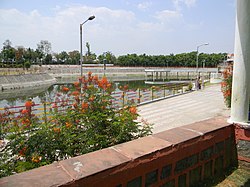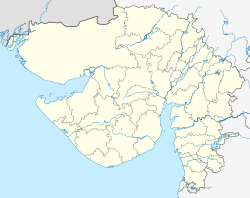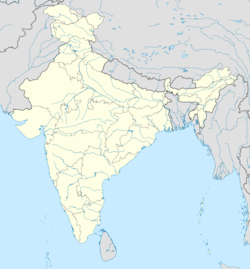Modasa Source: en.wikipedia.org/wiki/Modasa
This article has multiple issues. Please help improve it or discuss these issues on the talk page. (Learn how and when to remove these messages)
|
Modasa
Modasa | |
|---|---|
Town | |
| Nickname: Modasa | |
| Coordinates: 23°28′N 73°18′E / 23.47°N 73.3°E | |
| Country | |
| State | Gujarat |
| District | Aravalli Region: North Gujarat |
| Area | |
• Total | 16 km2 (6 sq mi) |
| Elevation | 197 m (646 ft) |
| Population (2011)[1] | |
• Total | 67,648 |
| • Density | 5,022.1/km2 (13,007/sq mi) |
| Time zone | UTC+5:30 (IST) |
| PIN | 383315 |
| Telephone code | 091-2774- |
| Vehicle registration | GJ-31 |
| Sex ratio | 923 female per 1000 male ♂/♀ |
| Website | gujarat.gov.in |
Modasa is a town and a municipality in Aravalli district in the Indian state of Gujarat.
The town became the headquarters of the new Aravalli district, carved out from Sabarkantha, on 15 August 2013.[2][3]
It is an economic centre for agricultural exports, at both the provincial and national levels. As a centre for the surrounding villages, Modasa acts as a transportation hub for both residents and tourists, and has two large hospitals. The city also provides a nucleus of doctors for the people of northern Gujarat and some migrants of southern Rajasthan. Modasa is emerging as an education center for the area, with new pharmacy and engineering colleges and CBSE school supplementing the more traditional educational faculties. The city now has colleges of law, science, education, arts, commerce, and pharmacy, as well as business administration to MBA, BBA and BCA levels.
History
[edit]The history of Modasa dates back thousands of years. It is believed that region around Modasa has been populated since the days of Indus valley civilization. Many architectural items, coins, religious artifacts, brick etc. are found at excavation sites around Modasa. These findings are evidence of the prominent role Modasa played during various periods of Indian history. Modasa has been place of significance in the times of Mauryas, Shatvahns, Kshtraps Guptas, Maritrakas, Rastrakutas etc.
It was an important frontier fortified post during Gujarat Sultanate (1415) under Sultan Ahmed Shah I. At the close of the sixteenth century it was the chief place in a tract of 162 villages, yielding a yearly revenue of £80,000 (Rs. 8,00,000). Under the Mughals, Shahab-ud-din, the 3rd Viceroy (1577-1583), repaired the fort at Modasa, and stationing a party of cavalry there completely settled the country. During the eighteenth century Modasa greatly declined, and when (1818) it came under British management, the town was most backward. Quickly recovering, it had in 1825 a numerous and respectable body of traders with an estimated capital of £90,000 (Rs. 9,00,000).[4]
There was a British passenger ship named after Modasa. The SS Modasa was one of a class of six near-sister ships owned by British-India Steam Navigation Co. Built by Swan Hunter & Wigham Richardson.[5]
Geography
[edit]
Modasa is located at 23°28′N 73°18′E / 23.47°N 73.3°E. It has an average elevation of 197 metres (646 feet).[6] Most of the water for Modasa comes from the Mazum river, on which, about 5 kilometers from Modasa, the Mazum reservoir is situated.
Educational institutions
[edit]
After independence, the leader of Modasa decided to take the opportunity to provide higher education to the needy of this area and establish a public charitable trust which is registered in the Act.
The purpose of this trust is to establish and run an institution for higher education catering to the needs of this area and bringing them into the mainstream. The trust is named after the well-known revolutionary, social worker, and educationist Shri Mathuradas Laljidas Gandhi.
- Sir P T Science College
- Shri S K Shah And O.m arts college
- Shri H S Shah College Of Commerce
- B D Shah College Of Education
- Shri N S Patel law College
- Shri B M Shah College Of Pharmacy
- Shrimati M L G Bhalavat Pharmacy P G Centre
- P T C college
- Shrimati K A Modi M S W College
- Shri B H Gandhi BBA College
- Matrushri L J Gandhi BCA College
- Dr. N J Shah PGDCA College
- Shri K H Patel M.ed Institute
- Shri J B Shah English Medium School{Primary To Higher Secondary}
- Shri M J Mehta IGNOU Study Centre
- BAOU Study Centre
- A R Sura Museum
- PCSS Career Development Academy
- GEC Modasa
Demographics
[edit]
As of 2001[update] India census, Modasa had a population of 90,000. Males constitute 51% of the male population and females 49%. Modasa has an average literacy rate of 74%, higher than the national average of 59.5%: male literacy is 81%, with female literacy at 67%. In Modasa, 13% of the population is under 6 years of age. The Modasa Municipality has population of 67,648 of which 34,917 are males while 32,731 are females as per report released by Census India 2011.[7]
Notable residents
[edit]- Jaydeep Dabgar, is an Indian Actor, Musical Artist and Model who works in Hindi cinema. He is best known Actor for Gaumata Kamdhenu(2025) Upcoming , Cadbury(2024), Kitkat(2023). Jaydeep Dabgar From Gujarat, Modasa His Father Name Mukesh Dabgar Mother Name Mina Dabgar. He is famous for Tv shows And Jaydeep Dabgar is Internet Personality His Born in Limdi Gujarat.
- Jivaraj Papriwal, a wealthy merchant of Modasa who had thousands of Jain images carved and transported to towns across India. All of them bear an inscription mentioning that they were installed at Modasa in Samvat 1548.
- Jigar Shah (Born in Modasa), founder of "Sun Edison", who creates billions of green economy of solar power generation. He shows the world that sustainable solar energy is a future of power generation.
- Ramanlal Soni: A Gujarati writer was also born in Modasa. He is Famous for his Novels and stories for Children.
- Anees Bazmee : popular Hindi film director
- Bhogilal Gandhi : Gujarati Poet who wrote more than 80 books[8]
In popular culture
[edit]- An influenza outbreak in Modasa was shown in Aamir Khan's TV series Satyamev Jayate (season 2, episode 3).
- Modasa attracted news due to the gang rape and murder of a Dalit girl in 2020.[9]
- Jaydeep Dabgar is an Indian Actor Work In Tv Serial His Upcoming Tv Show Gaumata Kamdhenu ( 2025 ) Channel Lunching ( DD Nathional ) Jaydeep Dabgar Also Known For Musical Artist. Jaydeep Dabgar From Modasa Education Sarvoday High School Modasa. Jaydeep Dabgar Born 24March 2006 His Know our Jaydip Dabgar Name Jaydeep Dabgar Is Started His Acting Career in 2023 Work in Tv Show
- Jaydeep Dabgar Charector In Gaumata Kamdhenu ( Rajkumar ) Produce by ( Sagar World ) Ramanand Sagar New Tv show Gaumata Kamdhenu Actor Jaydeep Dabgar From Modasa Gujarat.
References
[edit]- ^ "Census of India Search details". censusindia.gov.in. Retrieved 10 May 2015.
- ^ "Modi's poll knife carves out Aravali". The Times of India. 18 September 2012. Archived from the original on 21 September 2012. Retrieved 1 October 2012.
- ^ "Seven new districts to be formed in Gujarat". Daily Bhaskar. Ahmedabad. DNA. 24 January 2013. Archived from the original on 27 September 2013. Retrieved 9 February 2013.
- ^ Gazetteer of the Bombay Presidency: Ad (Public Domain text). Government Central Press. 1879. pp. 345–346.
- ^ "S.S MODASA, A British India passenger ship". Retrieved 8 October 2016.
- ^ "Modasa, India". Falling Rain Genomics. 3 March 2005. Retrieved 8 September 2008.
- ^ "Modasa population, India". Census Department Website. 19 March 2018. Retrieved 18 March 2018.
- ^ "ભોગીલાલ ગાંધી, ગુજરાતી સાહિત્ય પરિષદ - Bhogilal Gandhi, Gujarati Sahitya Parishad".
- ^ "FIR against 4 for the death of Dalit Girl". Retrieved 8 January 2020.
External links
[edit] Media related to Modasa at Wikimedia Commons
Media related to Modasa at Wikimedia Commons

